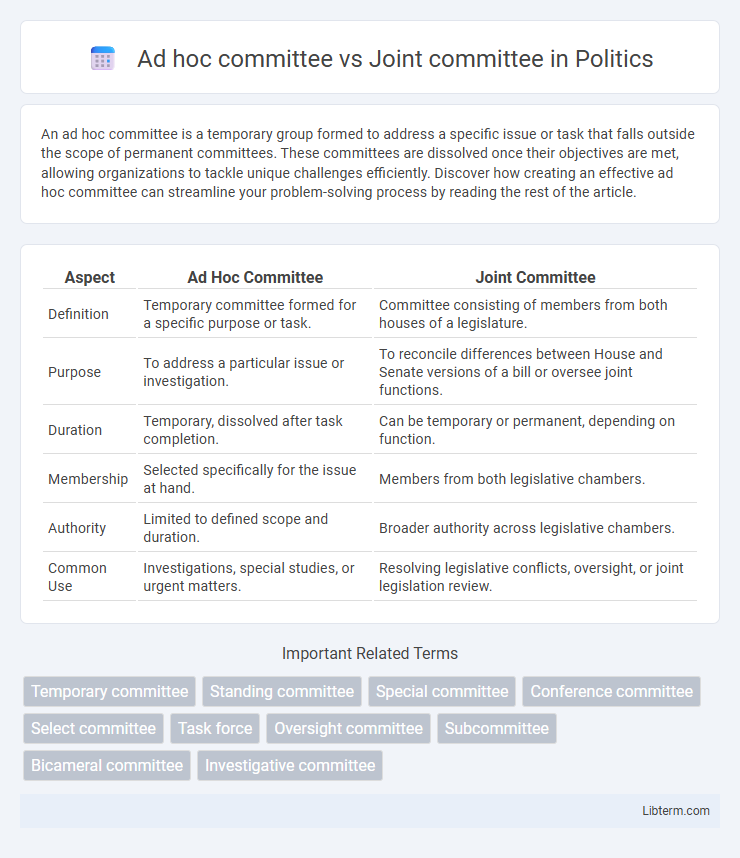An ad hoc committee is a temporary group formed to address a specific issue or task that falls outside the scope of permanent committees. These committees are dissolved once their objectives are met, allowing organizations to tackle unique challenges efficiently. Discover how creating an effective ad hoc committee can streamline your problem-solving process by reading the rest of the article.
Table of Comparison
| Aspect | Ad Hoc Committee | Joint Committee |
|---|---|---|
| Definition | Temporary committee formed for a specific purpose or task. | Committee consisting of members from both houses of a legislature. |
| Purpose | To address a particular issue or investigation. | To reconcile differences between House and Senate versions of a bill or oversee joint functions. |
| Duration | Temporary, dissolved after task completion. | Can be temporary or permanent, depending on function. |
| Membership | Selected specifically for the issue at hand. | Members from both legislative chambers. |
| Authority | Limited to defined scope and duration. | Broader authority across legislative chambers. |
| Common Use | Investigations, special studies, or urgent matters. | Resolving legislative conflicts, oversight, or joint legislation review. |
Introduction to Ad Hoc and Joint Committees
Ad hoc committees are temporary groups formed to address specific issues or tasks, dissolving once their objectives are met. Joint committees consist of members from both legislative chambers, collaborating permanently or periodically on particular areas of policy or administration. These committees play crucial roles in streamlining legislative processes and ensuring focused expertise on complex matters.
Definition of Ad Hoc Committee
An ad hoc committee is a temporary group formed to address a specific issue or task, dissolving once its objective is achieved. Unlike joint committees, which consist of members from multiple bodies or organizations and handle ongoing matters, ad hoc committees have a limited scope and duration. These committees are common in legislative and organizational settings where focused expertise or immediate action is required for a particular problem.
Definition of Joint Committee
A Joint Committee is a legislative body composed of members from both houses of a bicameral legislature, established to address specific issues that require collaboration between the two chambers. Unlike an Ad Hoc Committee, which is temporary and formed for a particular task or investigation, a Joint Committee often has a broader mandate and may operate on a continuous basis to oversee certain functions or coordinate policy. Joint Committees play a critical role in harmonizing legislation and facilitating communication between different branches of government.
Purpose and Functions of Ad Hoc Committees
Ad hoc committees are formed to address specific issues or tasks within a limited timeframe, dissolving once their objectives are achieved, whereas joint committees consist of members from both legislative chambers working on ongoing matters requiring cooperation. The primary purpose of ad hoc committees is to conduct focused investigations, draft special reports, or resolve particular problems that do not fall under the jurisdiction of standing committees. Their functions include gathering information, holding hearings, and making recommendations to the larger legislative body for decision-making or policy implementation.
Purpose and Functions of Joint Committees
Joint committees serve to address issues that span multiple legislative bodies, facilitating coordinated review and oversight of shared concerns such as budget allocations or policy implementation. Their primary function is to streamline legislative processes by conducting investigations, holding hearings, and producing reports that influence decision-making across both chambers. Unlike ad hoc committees, which are temporary and specific to a single issue, joint committees maintain ongoing roles to enhance inter-chamber collaboration and ensure consistent policy development.
Key Differences Between Ad Hoc and Joint Committees
Ad hoc committees are temporary bodies created for a specific task or issue, disbanding once their objective is achieved, whereas joint committees consist of members from both legislative houses, established for ongoing, permanent functions. Ad hoc committees have limited duration and focus strictly on a single matter, while joint committees address broader, continuous issues requiring coordination between chambers. The formation process also differs: ad hoc committees are often appointed for urgent or specialized purposes, whereas joint committees are institutionalized entities with roles defined by legislative rules.
Composition and Membership
Ad hoc committees consist of members appointed for a specific purpose or task, usually drawn from a single legislative body, with membership tailored to expertise related to the issue at hand. Joint committees are composed of members from both legislative chambers, such as the House of Representatives and the Senate, facilitating collaboration and unified decision-making on matters common to both bodies. Membership in joint committees is typically permanent or semi-permanent, whereas ad hoc committees dissolve once their assigned task is completed.
Duration and Dissolution
Ad hoc committees are established for a specific purpose and dissolved immediately after completing their task, making their duration temporary and limited. Joint committees consist of members from both legislative chambers and usually exist on a more permanent or semi-permanent basis to address ongoing issues or coordinate legislation. Unlike ad hoc committees, joint committees do not dissolve automatically after a single task but continue to function until officially disbanded or restructured.
Advantages and Limitations
Ad hoc committees offer flexibility and focus on specific issues with temporary mandates, enabling quick, specialized responses but may lack continuity and broader legislative influence. Joint committees, composed of members from both legislative chambers, facilitate coordination and unified decision-making on complex matters but often have limited authority to enact legislation independently. Understanding these distinctions helps optimize committee use for targeted problem-solving versus collaborative policymaking.
Conclusion: Choosing the Right Committee
Selecting the appropriate committee depends on the specificity and duration of the issue at hand; ad hoc committees are ideal for temporary, focused tasks requiring specialized expertise, while joint committees efficiently handle ongoing matters involving multiple legislative bodies. Understanding the scope and collaboration needed ensures effective decision-making and resource allocation. Careful evaluation of legislative goals enables lawmakers to capitalize on the strengths of each committee type.
Ad hoc committee Infographic

 libterm.com
libterm.com